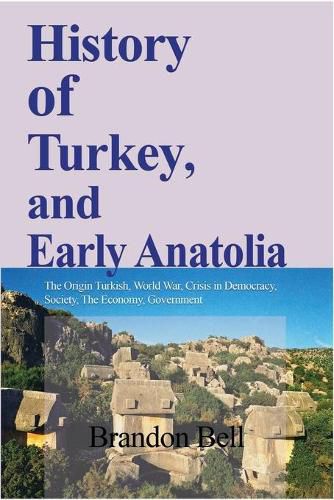Readings Newsletter
Become a Readings Member to make your shopping experience even easier.
Sign in or sign up for free!
You’re not far away from qualifying for FREE standard shipping within Australia
You’ve qualified for FREE standard shipping within Australia
The cart is loading…






This title is printed to order. This book may have been self-published. If so, we cannot guarantee the quality of the content. In the main most books will have gone through the editing process however some may not. We therefore suggest that you be aware of this before ordering this book. If in doubt check either the author or publisher’s details as we are unable to accept any returns unless they are faulty. Please contact us if you have any questions.
History of Turkey, and Early Anatolia. The Origin Turkish, World War, Crisis in Democracy, Society, The Economy, Government. Sociologists and other scholars, both Turkish and foreign, have noted that a majority of the population estimated at the end of 1994 at 61.2 million accepts as true Turks only those individuals whose native tongue is Turkish and who adhere to Sunni (see Glossary) Islam. This definition excludes a sizable minority of Turkish citizens from consideration as true Turks. The largest group within this minority is the Kurds, the overwhelming majority of whom speak Kurdish, an Indo-European language related to Persian, as their native tongue. In 1994 estimates of the size of the Kurdish minority in Turkey ranged from 10 to 20 percent of the country’s total population. Since 1990 demands by Kurdish political leaders that the Kurdish minority be permitted to read, write, and speak Kurdish have created a major political issue in Turkey (see Political Interest Groups. Although most adult Kurds are Sunni Muslims, perhaps as much as one-third of the total Kurdish population in Turkey belongs to a Shia Muslim sect known as Alevi.
$9.00 standard shipping within Australia
FREE standard shipping within Australia for orders over $100.00
Express & International shipping calculated at checkout
This title is printed to order. This book may have been self-published. If so, we cannot guarantee the quality of the content. In the main most books will have gone through the editing process however some may not. We therefore suggest that you be aware of this before ordering this book. If in doubt check either the author or publisher’s details as we are unable to accept any returns unless they are faulty. Please contact us if you have any questions.
History of Turkey, and Early Anatolia. The Origin Turkish, World War, Crisis in Democracy, Society, The Economy, Government. Sociologists and other scholars, both Turkish and foreign, have noted that a majority of the population estimated at the end of 1994 at 61.2 million accepts as true Turks only those individuals whose native tongue is Turkish and who adhere to Sunni (see Glossary) Islam. This definition excludes a sizable minority of Turkish citizens from consideration as true Turks. The largest group within this minority is the Kurds, the overwhelming majority of whom speak Kurdish, an Indo-European language related to Persian, as their native tongue. In 1994 estimates of the size of the Kurdish minority in Turkey ranged from 10 to 20 percent of the country’s total population. Since 1990 demands by Kurdish political leaders that the Kurdish minority be permitted to read, write, and speak Kurdish have created a major political issue in Turkey (see Political Interest Groups. Although most adult Kurds are Sunni Muslims, perhaps as much as one-third of the total Kurdish population in Turkey belongs to a Shia Muslim sect known as Alevi.